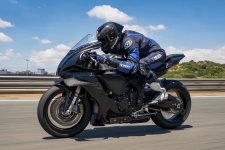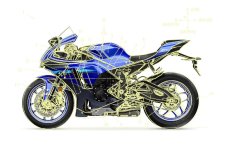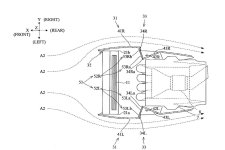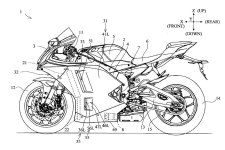kaninfaan
Gudomlig sporthojare
- Gick med
- 20 Apr 2024
- Hoj
- Kraftfahrzeug Trunkenpolz Mattighofen und/そして 2019 Yamaha R6
Updated Yamaha R1 superbike featuring clever aero package teased in new patent images
Skall ny aero rädda euro5+/euro6 certifiering?

och för att MCN's pay-or-spread-your-cheeks-wall verkar bromsa så paste'ar jag in hela artikeln här
-
2025 Yamaha R1 cornering on track

1 of 6
At the moment Yamaha’s R1 is a track-only superbike in European markets after the company opted not to uprate the design to meet the latest Euro5+ emissions requirements.
But that doesn’t mean development has come to a halt, and a new patent application reveals how active bodywork could be a key to not only improving performance but also meeting those pesky emissions limits.
The idea of movable shutters controlling the airflow through a cooling system isn’t new. It was relatively commonplace on prewar cars, with both manual and automated radiator shutter systems in use long before thermostats took over as a cheaper and simpler way of achieving the same goal of maintaining optimum engine temperatures.

In more recent years, cars have again returned to the idea with many modern models having hidden, automated shutters in their cooling openings, closing them off when not needed in pursuit of improved aerodynamics and better fuel economy.
Yamaha’s latest patent – showing new bodywork designed for the current-generation R1 – takes a slightly different route by installing the movable shutters on the cooling outlets in the fairing sides rather than the radiator intake at the front.
These are operated by small, fairing-mounted stepper motors – which move in defined steps and monitor their angular position – and a simple system of belts, keeping weight and cost down. Sensors monitor coolant temperature, catalyst temperature, outside air temperature, speed and throttle position, allowing a control unit to decide how much to open the vents.

The idea is that when the shutters are closed, airflow inside the fairing will be reduced, lowering the bike’s cooling capacity and creating a bubble of high-pressure air in front of the radiator intake that encourages more airflow around the sides of the bike.
The airflow running past the vents on the fairing, which is normally disrupted by the slow-moving, turbulent air that comes out of them, is also cleaned up, reducing the bike’s overall drag so it can reach higher speeds using less power, and the side fairing panels are more enclosing than the current design – covering the whole engine and giving a smoother path for the outside airflow.
Since bikes are designed with worst-case cooling scenarios in mind, like being stuck in traffic on hot days, the vents would be able to remain closed much of the time in cooler temperatures and at higher speeds, so the aero benefits could be substantial.

The patent also mentions the challenge of getting catalytic converters up to operating temperature fast and keeping them in the optimum range, explaining how the variable vents could assist in that task; an important one, particularly in light of the current-generation R1’s failure to meet Euro5+ rules.
It also describes how, by monitoring speed and throttle position, the system could be programmed to briefly sacrifice cooling in pursuit of better performance, keeping the vents closed under full throttle acceleration or near top speed, for example.
In World Superbike racing, where movable aerodynamics are allowed if they’re fitted as standard to the homologated street bike the racer is based on, that could be a key advantage.
Superbikes making a comeback

Suzuki’s recent revival of the GSX-R1000R as a Euro5+ European model, three years after its predecessor was dropped from the range in the face of Euro5 in 2022, shows that bikes can make a comeback after an emissions-enforced market withdrawal.
The fact that Yamaha engineers are working on ideas to update the R1, adding performance and improving emissions, is a positive sign that it, too, could be plotting a mainstream return.
:






Last edited:









